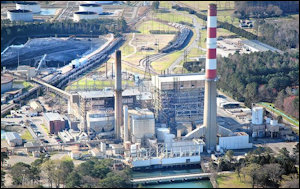
Yorktown Power Station. Photo credit: Daily Press
by James A. Bacon
In the late summer of 2015, Dominion Virginia Power issued grave warnings that residents and businesses of the Williamsburg-Newport News area could face electricity blackouts if the power company didn’t quickly receive permits to build the proposed 500 kV Surry-Skiffes Creek transmission line. When Dominion shuts down its aging, coal-fired units at the Yorktown Power Station in 2017, the company said, existing transmission lines serving the Virginia Peninsula would not have enough capacity to meet federal reliability standards on days of heavy power demand. Any kind of adverse event on the system would force the company to execute controlled blackouts in order to prevent an uncontrolled, cascading failure.
More than a year has passed, and the U.S. Army Corps of Engineers (ACOE) still has not ruled for or against Dominion’s Joint Permit Application to build the 20-mile, $179 million transmission line. Environmentalists and conservationists say that the transmission line would visually disrupt a historically significant stretch of the James River near Jamestown, and that Dominion never seriously explored alternative ways to meet the Peninsula’s electricity needs.
There are two main procedural steps yet to complete. First, Dominion must either complete or terminate a Memorandum of Understanding (MOU) detailing its plan to “mitigate” the negative impact of the transmission line. ACOE also must complete an “alternatives” analysis demonstrating that the Surry-Skiffes line is the most practical way to ensure a reliable supply of electricity to the Peninsula. Then the ACOE can conduct the final “public interest review” that weighs all the benefits and detriments of the proposal. Tom Walker, Norfolk chief of the COE’s regulatory branch, tells Bacon’s Rebellion he “won’t hazard a guess” as to how much longer it will take to complete the regulatory review.
To obtain a mitigation MOU, Dominion must get buy-in from the ACOE, the Virginia Department of Conservation and Natural Resources, and the Advisory Council on Historic Preservation (ACHP). More a dozen other “consulting parties” are invited to sign the MOU but their signatures are not required.
Foes of the Surry-Skiffes project say the high towers of the transmission line crossing the James River will be highly visible from the original Jamestown settlement and many other vantage points along the river where historic conservation is a high priority. Despoiling these views would desecrate Virginia’s “founding river.” Dominion counters that the towers will be barely visible on the horizon.
However, facing political reality, the power company has proposed a series of measures to mitigate whatever harm is done by the transmission line. In a draft agreement dated June 7, Dominion would dedicate $85 million to landscape, conservation and water-quality initiatives in the vicinity, coat the metal towers with a finish that minimizes glare, and initiate a heritage-tourism study. If, prior to the conclusion of the project’s 50-year lifespan, Dominion concludes the line is no longer needed, it will remove the towers and supporting infrastructure.
Those proposals don’t come close to mollifying the more outspoken opponents of the project. “This can’t be mitigated,” says Margaret Nelson Fowler, co-founder of the Save the James Alliance. “From what I’m told, the consulting parties are nowhere close to an agreement. ACHP is pretty far apart from Dominion.”
“Termination does not kill the project,” says ACOE’s Walker. But it does create a higher hurdle for Dominion to surmount when the ACOE conducts its final public interest review. Working in Dominion’s favor is the fact that the ACOE has ascertained that proposed alternatives such as installing scrubbers on the Yorktown power units or converting them to natural gas are not practical. However, even that determination is tentative, based on the information the ACOE had at the time, and could be revised.
Whatever solution Dominion pursues, time is of the essence. Last week, the Daily Press’s David Ress reported that Dominion ran its Yorktown coal-fired units on 20 days this past July and August. Dominion is under EPA orders to fire up the polluting boilers only when absolutely needed to preserve the reliability of service to the Peninsula; the units must be shut down next spring. Wrote Ress:
If the Yorktown plants had not run on those occasions, any failure on the high voltage lines serving the Peninsula could have forced PJM — the operator of the electric grid serving 13 states from New Jersey west to Illinois and south to North Carolina — to order interruptions of electric service, PJM spokesman Ray Dotter said.
Even if Dominion got the go-ahead to build the transmission line tomorrow, construction would take more than a year. Given the prospect of blackouts next summer, does ACOE feel a sense of urgency in reaching a conclusion one way or the other?
Walker did not answer that question directly, but said that ACOE is obligated to follow a certain process. The ACOE is “moving as expeditiously as possible,” he said. “We do have folks focused on this thing.”


